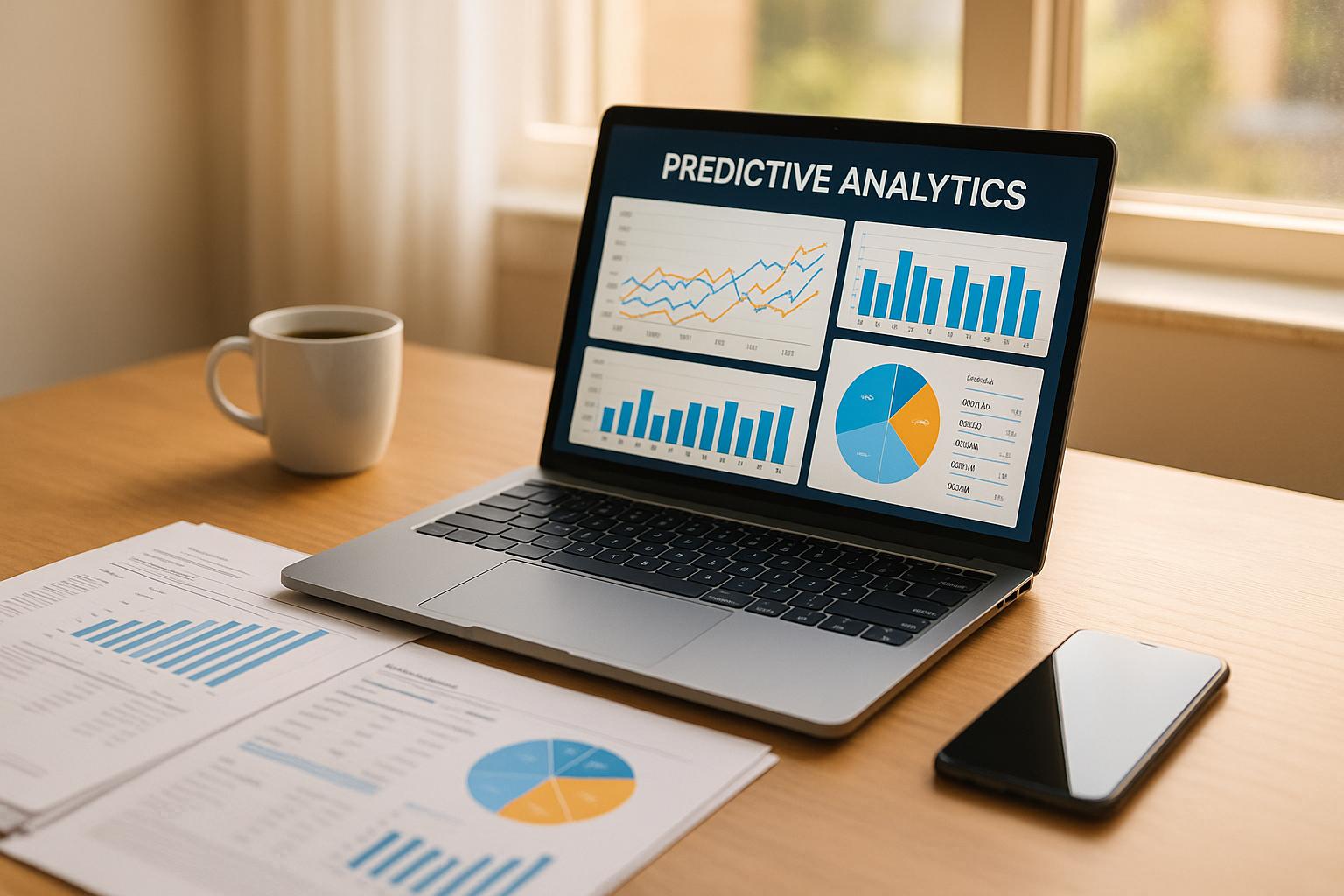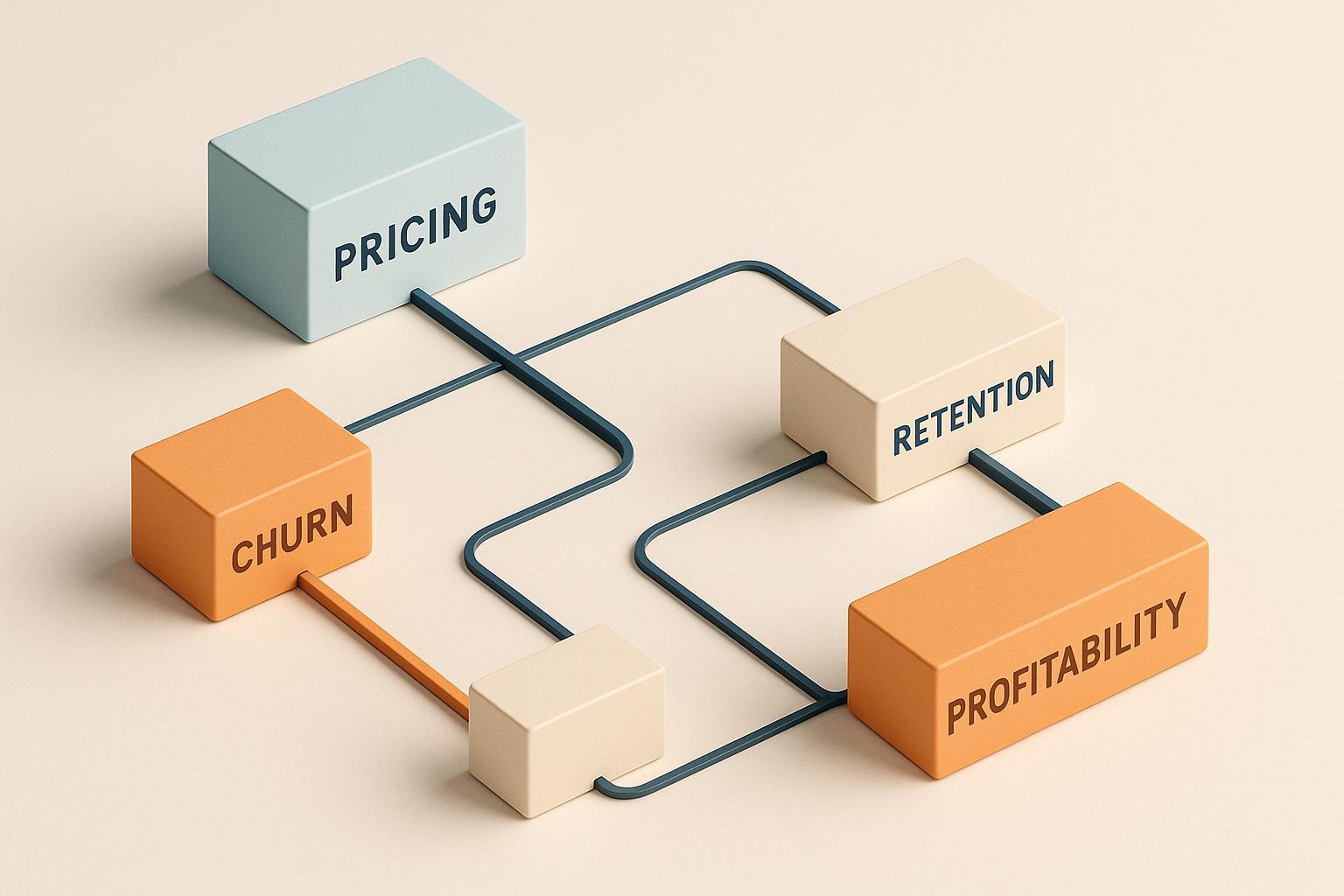Predictive Analytics in Financial Planning

Predictive analytics is reshaping financial planning by helping businesses make smarter, faster decisions using historical data, real-time inputs, and advanced modeling techniques. By identifying patterns and forecasting potential outcomes, companies can improve financial accuracy, manage risks, and optimize cash flow. Here's a quick breakdown of what you need to know:
- What It Is: Predictive analytics uses data, machine learning, and statistical tools to forecast financial trends and outcomes.
- Why It Matters: It enables real-time insights, better risk management, and faster decision-making in a fast-changing business environment.
- Who Benefits: Mid-sized companies, startups preparing for funding, and businesses scaling operations or entering new markets.
- Key Applications:
- Revenue forecasting
- Risk detection (credit risk, fraud prevention)
- Cash flow management
- Budgeting and expense control
- Customer behavior prediction
Predictive analytics transforms financial planning from reactive to forward-looking, equipping businesses with actionable insights to stay competitive. Let’s dive deeper into how it works and why it’s becoming indispensable for modern financial strategies.
Benefits of Predictive Analytics in Financial Planning
Predictive analytics is reshaping financial planning by offering clear, actionable benefits that help businesses improve profitability and efficiency. It’s more than just crunching numbers - it’s about transforming how companies approach strategy and manage risks. Below, we explore how predictive analytics enhances forecasting, mitigates risks, and streamlines cash flow management.
Better Accuracy in Financial Forecasting
Traditional forecasting methods often rely on outdated models based on historical trends, which can lead to mismatches between expected and actual results. Predictive analytics changes the game by incorporating real-time data, seasonal patterns, and economic indicators. By analyzing diverse data streams - like customer purchasing behaviors, supplier payment cycles, and market fluctuations - businesses can achieve much more precise forecasts.
For growing companies, this accuracy translates into smarter resource allocation, better management of working capital, and informed decisions about inventory and capital expenditures. Machine learning plays a key role here, as it continuously updates forecasts with new data, improving results over time.
Risk Management and Prevention
Predictive analytics excels at identifying financial risks early by analyzing a wide range of data points. For example, credit risk assessments no longer depend solely on credit scores or payment histories. Instead, predictive models evaluate customer behavior, industry trends, and broader economic conditions to anticipate potential defaults. This allows businesses to adjust payment terms or collections strategies proactively.
These tools also monitor economic and industry-specific metrics to flag potential issues like market volatility, supply chain disruptions, or pricing challenges. On top of that, advanced fraud detection systems identify irregularities such as unusual spending patterns, duplicate payments, or suspicious vendor activity, helping companies protect their financial assets.
Cash Flow Optimization
Managing cash flow becomes far more efficient with predictive analytics. These models provide highly accurate forecasts for both incoming and outgoing cash flows, ensuring businesses maintain the right balance of liquidity without tying up unnecessary capital.
On the accounts receivable side, predictive tools analyze customer payment behaviors and seasonal trends to estimate when payments will arrive, helping businesses plan collections more effectively. For accounts payable, analytics can pinpoint the best times to pay invoices - whether that means taking advantage of early payment discounts or extending terms during tighter liquidity periods. This level of insight helps companies navigate seasonal cash flow fluctuations and make smarter decisions about inventory, staffing, and investments.
Better Decision-Making
Predictive analytics empowers executives to make faster, more confident decisions by offering real-time insights into financial health and future projections. Unlike traditional monthly reports, updated dashboards provide up-to-the-minute data, enabling sharper strategic planning.
When it comes to investments, these tools allow businesses to model different scenarios - whether they’re considering new equipment, market expansion, or research and development projects. Budget allocation also becomes more precise, shifting from generic percentage-based methods to data-driven strategies that align resources with expected performance. Predictive analytics is particularly valuable for major strategic moves like acquisitions, launching new products, or entering new markets, helping reduce uncertainty and identify the most promising opportunities.
According to Phoenix Strategy Group, companies that adopt predictive analytics often see substantial improvements in forecast accuracy within their first year. This greater precision not only supports ambitious growth strategies but also strengthens risk management, paving the way for accelerated business success.
Key Data and Methods in Predictive Analytics
To build effective predictive analytics models, you need the right mix of data sources and analytical methods. Combining high-quality, diverse data with the right techniques directly improves the accuracy of your predictions.
Data Types for Predictive Analytics
Historical financial data forms the backbone of predictive analytics. Think income statements, balance sheets, and cash flow statements spanning several years. Ideally, 3–5 years of historical data helps models uncover patterns and trends that would otherwise go unnoticed.
Transactional data provides a daily snapshot of business activities. This includes sales transactions, purchase orders, invoice payments, and customer interactions. For example, tracking payment timing can refine cash flow forecasts by identifying when payments are typically received.
Market and economic data adds critical external context to internal metrics. Examples include industry benchmarks, GDP growth, unemployment rates, interest rate shifts, and commodity prices. A manufacturing company, for instance, might monitor steel prices and labor costs to better forecast production expenses.
Customer and supplier data uncovers behavioral insights that go beyond financial statements. Customer demographics, purchase histories, seasonal buying habits, and credit scores can help predict revenue trends. On the supplier side, metrics like delivery times, quality ratings, and payment terms aid in expense forecasting.
Operational metrics link day-to-day activities to financial outcomes. Metrics like inventory turnover, employee productivity, capacity utilization, and quality control statistics provide actionable insights. For example, a retailer tracking foot traffic and conversion rates can better estimate monthly sales.
Once you’ve gathered robust data, the next step is selecting the right analytical techniques to turn raw information into actionable insights.
Common Predictive Analytics Techniques
Regression analysis is a go-to method for financial forecasting. Linear regression works well for predicting outcomes like revenue based on variables such as marketing spend or seasonal trends. For more complex scenarios, multiple regression models can analyze several factors at once - for example, estimating quarterly sales using marketing budgets, competitor pricing, and consumer confidence levels.
Time series analysis is ideal for metrics that follow regular patterns over time. It’s particularly useful for identifying seasonal trends, cyclical behaviors, and long-term growth. For instance, businesses often use time series models to predict monthly cash flows, accounting for recurring events like holiday sales or tax payments.
Machine learning algorithms excel at uncovering complex relationships between variables. Decision trees can pinpoint the most influential factors driving financial outcomes, while neural networks detect subtle patterns in large datasets. Random forest models, which combine multiple decision trees, further enhance accuracy and reduce overfitting.
Classification models are valuable for tasks like risk assessment and fraud detection. These techniques categorize customers, transactions, or scenarios into risk levels. For example, a credit scoring model might classify customers as low, medium, or high risk based on factors like payment history and financial stability.
Clustering analysis groups similar data points, revealing patterns in customer behavior or market segmentation. This can help identify which customer groups are likely to spend more or which market segments carry higher credit risks.
When paired with high-quality data, these techniques enable precise financial forecasting and better decision-making.
Data Quality and Real-Time Updates
Having the right data and methods is just the start - maintaining data quality is equally important.
Data accuracy is essential for reliable models. Even the best algorithms can’t compensate for incomplete or incorrect data. Regular audits can help identify inconsistencies, duplicates, or missing values. Automated validation rules, like flagging unusual transactions or blank fields, catch errors early.
Real-time data synchronization ensures models stay relevant. Financial conditions can change in an instant, and outdated information makes predictions unreliable. Modern platforms integrate with accounting systems, CRM tools, and external data feeds to keep models up-to-date.
Data standardization is key when combining information from different sources. Establishing consistent formats for dates, currencies, and units ensures accuracy when merging data from systems like CRMs and accounting software.
Historical data validation checks past predictions against actual outcomes to gauge model performance. This process, known as backtesting, identifies when models need adjustments or retraining. Regular validation ensures predictions remain reliable as business conditions evolve.
Applications and Use Cases of Predictive Analytics in Financial Planning
Predictive analytics transforms raw data into actionable strategies, offering a smarter way to tackle financial challenges. Its applications span across various aspects of financial management, making it a valuable tool for businesses aiming to refine their decision-making processes.
Revenue and Investment Forecasting
Revenue forecasting has become more precise by incorporating multiple data sources. Instead of relying solely on past sales figures, businesses now analyze customer behavior, market trends, and operational metrics to predict future income. For subscription-based companies, predictive models can pinpoint monthly recurring revenue by factoring in customer acquisition costs, churn rates, and usage patterns. These forecasts even account for seasonal variations and broader economic indicators, providing a dynamic view of revenue streams.
When it comes to investment planning, predictive analytics helps businesses make smarter decisions about where and when to allocate resources. By analyzing historical data, current market trends, and associated risks, companies can determine the best timing for investments like equipment upgrades, facility expansions, or new technology.
Predictive tools also uncover revenue opportunities by diving into customer data. By studying purchase histories, demographics, and engagement levels, businesses can identify which products or services are likely to yield the highest returns. This replaces guesswork with evidence-based strategies, ensuring investments align with market demand.
Another critical area is cash conversion cycle optimization. Predictive models evaluate accounts receivable, payment behaviors, and customer credit profiles, enabling businesses to forecast when invoices will be paid. This insight supports accurate cash flow projections and helps optimize working capital.
These revenue-focused insights naturally complement efforts to manage expenses more effectively.
Expense Management and Budgeting
Cost forecasting has evolved with predictive analytics, offering businesses a way to integrate operational drivers and external factors into their budgeting. By analyzing how activity levels impact expenses, companies can create budgets that adapt to changing conditions.
For businesses with fluctuating demand, variable cost prediction becomes essential. Predictive models can estimate utility costs based on production schedules, forecast shipping expenses tied to sales, and calculate labor costs influenced by seasonal hiring needs. This level of detail helps businesses identify cost-saving opportunities before expenses escalate.
Budget variance analysis is another area where predictive analytics shines. By comparing current spending patterns with historical data, businesses can spot potential budget overruns early. This allows for proactive adjustments rather than reactive fixes, keeping financial plans on track.
Predictive analytics also streamlines vendor and supplier cost management. By analyzing commodity prices, supplier performance, and contract terms, businesses can anticipate cost changes and negotiate better deals. This forward-looking approach ensures procurement strategies remain efficient.
Additionally, businesses can enhance operational efficiency by identifying which costs directly contribute to revenue and which represent waste. Predictive models guide decisions on resource allocation, ensuring every dollar spent drives meaningful outcomes.
With expenses under control, businesses can shift focus to mitigating risks and enhancing security.
Fraud Detection and Risk Mitigation
Transaction monitoring powered by predictive analytics detects suspicious activities in real-time. By analyzing spending patterns and transaction details, these systems flag anomalies that could indicate fraud.
For assessing credit risk, predictive tools combine data from multiple sources to gauge customer payment behavior. This enables businesses to make informed decisions about extending credit terms, reducing the likelihood of bad debt.
Internal fraud prevention is another critical application. Predictive models analyze employee expense reports, procurement activities, and financial transactions to identify unusual patterns. By flagging deviations from the norm, businesses can investigate and address potential fraud before it escalates.
In the realm of regulatory compliance, predictive analytics ensures adherence to financial rules. These systems can predict when thresholds might be exceeded, flag transactions requiring additional documentation, and identify activities that could attract regulatory scrutiny.
Insurance and risk management also benefit from predictive models. By analyzing claims data, operational metrics, and external factors, businesses can forecast potential losses, optimize insurance coverage, and implement preventive measures to reduce risk exposure.
Customer Behavior Prediction
Customer lifetime value modeling combines transaction data, engagement metrics, and demographics to estimate the long-term value of customers. These models help businesses identify high-value segments, predict churn risks, and refine retention strategies.
Churn prediction is another powerful tool, analyzing usage trends, payment histories, and support interactions to identify customers at risk of leaving. This allows businesses to take proactive steps to retain valuable accounts.
For businesses managing inventory, purchase behavior forecasting offers a competitive edge. By analyzing seasonal trends, promotional responses, and customer preferences, companies can anticipate demand and optimize supply chain operations, ensuring they’re always prepared.
Payment behavior analysis predicts when customers are likely to pay invoices and flags accounts that may require collection efforts. By incorporating payment histories and external economic factors, businesses can improve cash flow and minimize bad debt.
Lastly, predictive analytics reveals cross-selling and upselling opportunities by analyzing customer preferences and purchase histories. This targeted approach enhances sales efficiency and boosts customer satisfaction by offering products or services that align with their needs.
For growth-stage companies looking to harness these capabilities, partnering with experts like Phoenix Strategy Group can make all the difference. Their blend of predictive modeling expertise and financial know-how ensures businesses can turn insights into actionable strategies that deliver measurable results.
These real-world applications highlight the transformative potential of predictive analytics, paving the way for its seamless integration into financial operations.
sbb-itb-e766981
Integrating Predictive Analytics into Financial Operations
Bringing predictive analytics into financial operations requires combining diverse data sources, automating workflows, and setting up clear governance to provide actionable financial insights.
Technology Integration and Automation
At the heart of predictive analytics is data integration. Using ETL (Extract, Transform, Load) processes helps break down silos, ensuring data is accurate, accessible, and shared across departments. This creates a solid foundation for predictive models.
Connecting ERP systems like NetSuite, QuickBooks Enterprise, or SAP allows forecasts to update in real time. This ensures that teams always have access to the most current data for making informed decisions. Automated alerts can flag when predictions veer off track, enabling swift adjustments to keep operations aligned.
Choosing the right software is equally important. Platforms that support predictive analytics across financial functions - such as accounts receivable automation, reporting, budgeting, and tax management - simplify implementation. These tools reduce complexity, minimize training needs, and ensure consistency while maintaining data integrity throughout financial processes.
To maintain trust in predictive insights, automated testing protocols should validate models against historical data, identifying any deviations from actual outcomes. These technical integrations not only improve reliability but also pave the way for expert advisory services to enhance growth strategies.
Using Advisory Services for Growth
For businesses in growth phases, internal expertise in predictive analytics might be limited. Partnering with financial advisory services can fill this gap, offering specialized knowledge in data engineering, FP&A (financial planning and analysis), and modeling without adding to internal overhead.
Take Phoenix Strategy Group, for example. They combine financial expertise with data engineering to integrate predictive analytics into financial planning. This approach supports scaling efforts, fundraising, and even preparing for eventual exits.
Fractional CFO services are particularly helpful during the implementation phase. These professionals guide technology selection, oversee integration, and ensure predictive insights align with a company’s broader financial goals. Meanwhile, data engineering support tackles challenges like data quality and accessibility by building robust pipelines, establishing governance protocols, and automating quality checks.
By blending strategic advisory with technical execution, these services embed predictive analytics into everyday financial operations, making them an integral part of planning and risk management.
Best Practices for Implementation
To ensure a smooth and effective implementation, it’s essential to establish clear KPIs, such as improving cost efficiency, managing risks, and enhancing revenue forecasting.
Managing data quality is critical. This involves setting up processes for cleansing and validating data, standardizing formats, automating quality checks, and maintaining thorough documentation. Alongside this, training programs should help teams understand how to interpret model outputs and identify which data inputs yield reliable results.
Implementing continuous improvement protocols keeps systems effective over time. Regularly refining models, updating data sources, and adjusting algorithms in response to evolving business needs ensures the system remains relevant. Additionally, integrating predictive analytics into daily workflows makes forecasts and risk assessments a natural part of decision-making.
Finally, performance monitoring creates feedback loops to compare predictions with actual outcomes. By tracking accuracy, identifying error patterns, and refining models, companies can continuously improve the value of their predictive analytics systems.
When thoughtfully implemented with the right technology, expertise, and processes, predictive analytics can revolutionize financial planning and decision-making, enabling businesses to operate with greater confidence and precision.
Conclusion: The Future of Predictive Analytics in Financial Planning
Predictive analytics has become a game-changer in financial planning, offering businesses sharper forecasting, better risk management, improved cash flow strategies, and smarter decision-making. By anticipating customer behavior, spotting potential fraud, and fine-tuning budgets, companies gain the competitive advantage needed to thrive in today’s fast-paced environment.
This shift moves financial planning from a reactive approach to a proactive one. Instead of relying solely on historical data, companies now use advanced algorithms and real-time insights to make informed decisions. While this transition comes with challenges - like integrating data systems and validating predictive models - strategic partnerships can help bridge the gap.
For example, firms like Phoenix Strategy Group combine financial expertise with data engineering to guide mid-market companies through these hurdles. By embedding predictive analytics into their financial planning processes, they help businesses tackle everything from fundraising to exit strategies. This holistic approach ensures that predictive insights aren’t just theoretical but become practical tools shaping daily operations.
As the financial planning landscape becomes increasingly digital and automated, adopting predictive analytics is no longer optional - it’s essential. Companies that embrace this technology today will be better equipped to handle uncertainty, seize opportunities, and drive sustainable growth. The real question is no longer if you should integrate predictive analytics, but how quickly you can make it part of your financial strategy.
With the growing complexity of business operations and the sheer volume of data being generated, predictive analytics will be the backbone of confident, data-driven financial decisions in the years to come.
FAQs
How does predictive analytics make financial forecasts more accurate than traditional methods?
Predictive analytics improves financial forecasting by using advanced algorithms, machine learning, and real-time data to identify patterns and trends that traditional methods often overlook. By processing large volumes of data and pinpointing subtle correlations, this approach delivers more accurate and actionable predictions.
Older forecasting techniques, which depend largely on historical data and personal judgment, often fall short when faced with fast-changing market dynamics or intricate variables. Predictive analytics bridges these gaps, enabling businesses to make smarter decisions, mitigate risks, and maintain a competitive edge.
What challenges do businesses face when using predictive analytics in financial planning, and how can they address them?
When businesses dive into predictive analytics for financial planning, they often hit a few roadblocks. Common hurdles include poor data quality, outdated legacy systems that don't play nice with new tools, and a shortage of skilled professionals to manage and interpret the analytics. These challenges can hold companies back from fully tapping into the advantages of predictive tools.
To overcome these obstacles, it’s crucial to take a strategic approach. Start by strengthening data governance to ensure your data is accurate and consistent - bad data leads to bad decisions. Invest in training programs to equip your team with the skills they need to handle predictive analytics effectively. Finally, focus on integrating systems so that your predictive tools work seamlessly with your existing workflows and technology. By tackling these challenges head-on, businesses can harness the power of predictive analytics to make smarter financial choices and pave the way for sustainable growth.
How does predictive analytics help identify and reduce financial risks like credit defaults and fraud?
Predictive analytics empowers financial institutions to tackle risks head-on by leveraging machine learning, artificial intelligence, and historical data to anticipate potential problems. This means more precise credit evaluations and the ability to detect fraudulent activities early on.
By examining patterns and trends, predictive models generate detailed risk profiles. These insights help businesses make smarter decisions, streamline operations, and avoid major financial setbacks. It's become an essential strategy in today's financial planning, paving the way for stronger risk management and greater long-term security.




